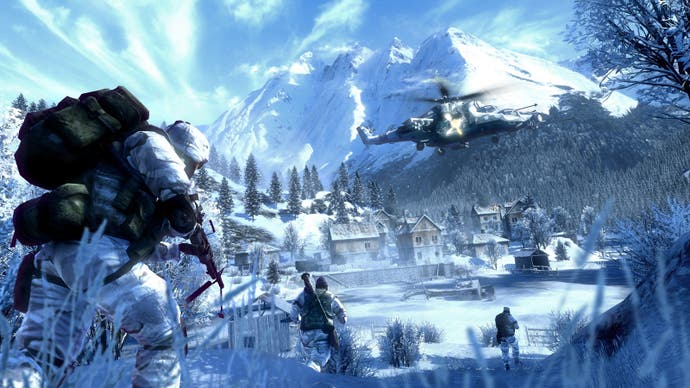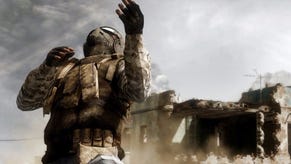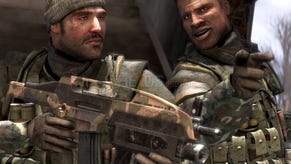Battlefield: Bad Company 2
Company account.
After watching and reading about Volition's Red Faction: Guerrilla earlier this month, you could be forgiven for turning your nose up at Battlefield: Bad Company 2's "Destruction 2.0". It goes further than the first game's technology, allowing you to flatten whole buildings, but it rather pales next to the insane calculations going on in Guerrilla, where legend has it that designers had to be given structural training because their unrealistic buildings kept falling down under the weight of real physics.
For example, I'm watching producer Patrick Bach play through a seemingly complete single-player mission in Bad Company 2 when he's given a laser designator and instructed to paint a meddlesome tank for air support. Incoming jets immediately take it out and flatten a pair of two-storey buildings adjacent to it, which fall down behind a convenient veil of flying debris and smoke. It looks great, leaving nothing behind (the main criticism of Bad Company's tech was that you couldn't knock everything to the ground), and DICE's Frostbite engine handles it comfortably on the 360 devkit. But you can't, for instance, ram a few RPGs into one of the walls so that the masonry tumbles onto the tank, just to see if it works. It's not as emergent as Red Faction claims it's going to be. Why not?
DICE creative director Lars Gustavsson says it's because the team has sacrificed advanced destruction in favour of other things. "I think we've found a really good level," he says. "It is really worth having the perfect destruction model, if it means that we can have fewer vehicles and players, we can't replicate it over network, and so on?" The goal is to achieve the perception of destruction, rather than the reality of it, and Gustavsson's happy with that. "[It's] to the point where you don't really question it when you play - that's the key thing. If we manage to reach that threshold, then it's definitely good enough. To go beyond that would almost be irresponsible; then it's a tech demo, and it will come at the price of something else."
That's fighting talk if you ask me, but then again, Volition wasn't exactly bashful when it said it was "ahead of everybody by five to ten years in terms of destruction". Battlefield series executive producer Karl-Magnus Troedsson makes a slightly different point with help from an unlikely source. "Our vegetation destruction might not be as advanced as some of the other competitors might do it," he admits, "but on the other hand we can have 10,000 trees in the level, which we did in Bad Company 1. In this case, quantity is a quality in itself." He pauses. "I think Stalin said that actually, so maybe it was a bad thing to say! Yes, he talked about the amount of tanks they had."

Bad Company 2 has lots of tanks as well, but before we get to that, let's set it up a bit. The sequel to DICE's first ever single-player game, Bad Company 2 puts you back in control of Preston, one of four self-involved US soldiers who adopt an idiosyncratic approach to warfare. The first game saw them on the hunt for gold in a warzone, Three Kings-style, and while DICE is curiously reluctant to talk about the story in Bad Company 2, Gustavsson and Troedsson agree that it's a bit less tongue-in-cheek. "I would say that the guys have had their honeymoon," Gustavsson offers. "They were out there in the middle of a war, everything going on, not so much focused on the war, didn't have to worry about it; more worrying about court martial and missing out on the gold. But those times are gone and now life is turning more serious and they have to face what they're up to."
But that's not to say Preston and friends are toeing the line completely. "It's almost like you take the guys from Three Kings and you throw them into a Tom Clancy scenario," Troedsson says. "It's still going to be the guys driving around the desert throwing baseballs with C4 on them and shooting at them or whatever it was that they did." It was American footballs - I secretly love George Clooney. "But they're going to be in a scenario that forces them, at times, to be more serious."

Until we're told more about that, there's the contents of the single level we're shown to consider. Set in the village of Abkhazi, surrounded by snow-covered mountains, it starts with a simple recon job, and quickly escalates once the Bad Company boys start across a frozen lake and spy Russians loading something into a truck. Instructions come down the wire to take them out, and after Sarge slices a patrolman's throat things quickly escalate into a classic iron-sights engagement in a crate-filled street, ducking out of the way of RPGs fired from windows as enemy flares go up to signal for reinforcements.
It hits all the usual buttons at this end of the FPS spectrum - darting between helpful cover (which now gradually disintegrates in accordance with Destruction 2.0), past burnt-out vehicle husks and into burnt-out buildings, trading fire with the Russians and occasionally segueing into an in-line set-piece - using a grenade launcher on a 50-cal emplacement, for example, or the aforementioned use of air support.







.png?width=291&height=164&fit=crop&quality=80&format=jpg&auto=webp)




.jpg?width=291&height=164&fit=crop&quality=80&format=jpg&auto=webp)
